Comparison of Single Atoms vs. Sub-Nanoclusters as Co-Catalysts in Perovskites and Metal Oxides for Photocatalytic Technologies
Abstract
1. Introduction
1.1. Single Atom Catalysts (SACs) and Single Atom Co-Catalysts (SACCs)
| Ad Atom | Co | Ni | Cu | Sn | Bi | Pd | Ag | Pt | Au |
|---|---|---|---|---|---|---|---|---|---|
| Most common Oxidation State while on support | 2+ | 2+ | 2+ | 2+ | 3+ | 0 | 0 | 0 | 0 |
| Atomic Diameter (Å) * | 1.09 | 1.10 | 1.14 | 1.44 | 1.92 | 4.04 | 3.44 | 1.2 | 2.74 |
| Atomic Weight ** | 58.93 | 58.69 | 63.55 | 195.08 | 106.42 | 107.87 | 118.71 | 196.97 | 208.98 |
1.2. Perovskites in Photocatalysis
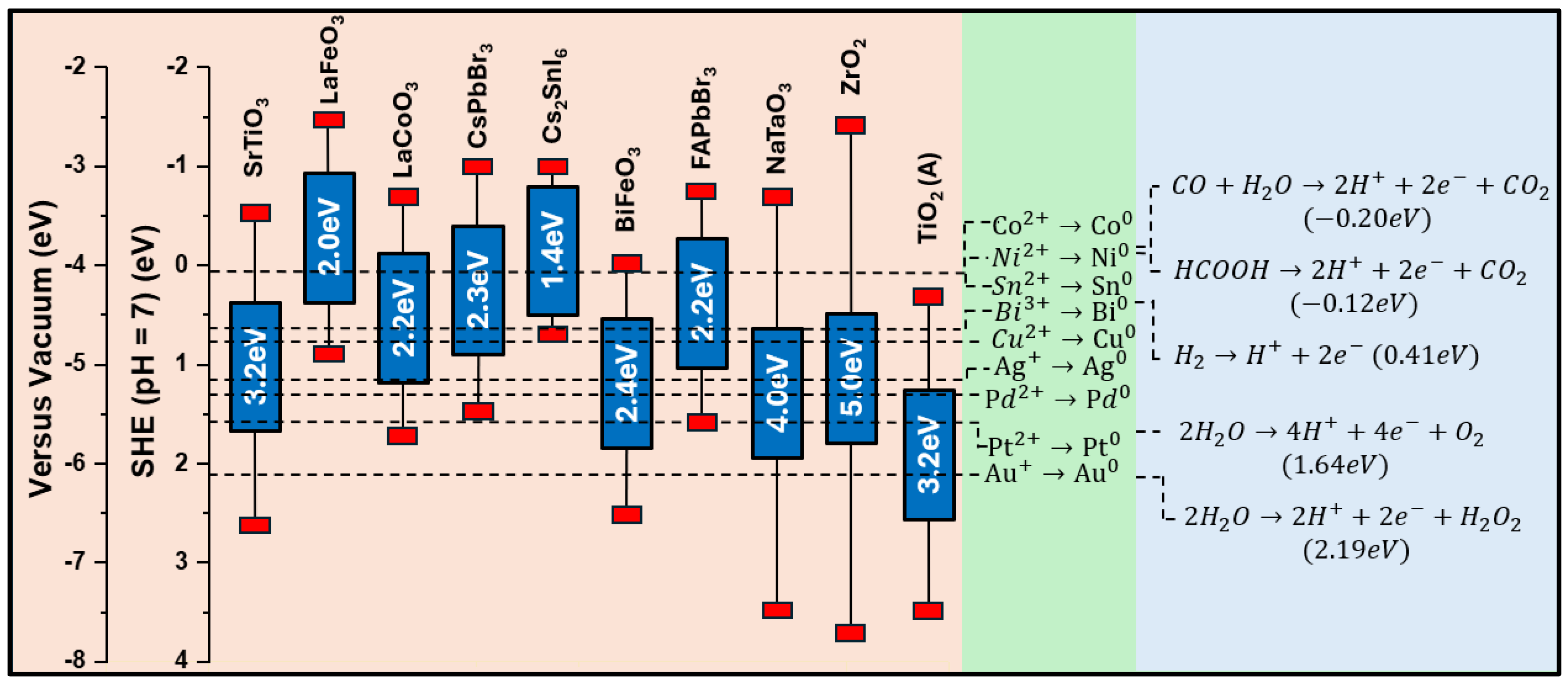
- The synthesis methods. Due to the demanding nature of the controlled formation of SAs vs. NCs vs. QSSPs and their anchoring on the catalytic particle, synthesis poses standalone challenges. This may result in a mixture of SAs and NCs or NCs and QSSPs. We discuss cases where these issues are not clear or there are misassignments of SAs to NCs or NCs to QSSP and vice versa.
- The detection–analysis methods. The de facto low-atom concentration required to form SAs, NCs, or QSSPs excludes their detection by traditional material characterization methods, e.g., X-ray diffraction, and requires specific spectroscopic microscopy techniques, often a combination of them. We discuss examples where a specific method provides the most convincing data on the distinction between SAs, NCs, and QSSPs.
- The performance characteristics. The gain in performance determines whether SA, NCs, or QSSPs are preferable for a specific photocatalytic system. We discuss examples where a clear benefit is achieved by a certain configuration and discuss possible trends and generalizations, if allowed by the data.

2. Synthesis Methods
2.1. Wet Chemical Synthesis Methods
2.2. Dry Chemistry Synthesis Methods
|
Nanostructures/ Substrates | Co-Catalyst | Synthesis Method | Classification of Synthesis Method | Ref. |
|---|---|---|---|---|
| LaFeO3 | Au | Deposition Precipitation | Wet chemistry | [68] |
| CsPbBr3 | Pt | Photo-deposition | Wet chemistry | [86] |
| SrTiO3 | Pt | Wet Impregnation | Wet chemistry | [87] |
| Cs2SnI6 | Pt | Wet Impregnation | Wet chemistry | [88] |
| CsPbBr3 | Pt | Photoreduction | Wet chemistry | [89] |
| FAPbBr3−xIx (FA = CH(NH2)2) | Pt | Co-precipitation | Wet chemistry | [90] |
| NaTaO3 | Ni | Flame Spray Pyrolysis | Dry chemistry | [74] |
| LaCoO3 | Pt | Solution-Mediated Adsorption | Wet chemistry | [91] |
| SrTiO3 | Ni | E-Beam Evaporation | Dry chemistry | [92] |
| BiFeO3 | Co | Immersion | Wet chemistry | [93] |
| SrTiO3 | Pd | Photo-deposition | Wet chemistry | [94] |
| SrTiO3 | Au | Sputtering | Dry chemistry | [95] |
| TiO2 | Cu | MOF synthesis | Wet chemistry | [96] |
| TiO2 | Cu | Wet Impregnation | Wet chemistry | [97] |
| TiO2 | Pd | Flame Spray Pyrolysis | Dry chemistry | [71] |
| ZrO2 | Ni | Solvothermal | Wet chemistry | [98] |
| ZrO2 | Pt | Wet-Impregnation | Wet chemistry | [99] |
3. Characterization Techniques for Detection of SACCs/NCs/QSSPs
3.1. Indirect Characterization of SACCs/NCs
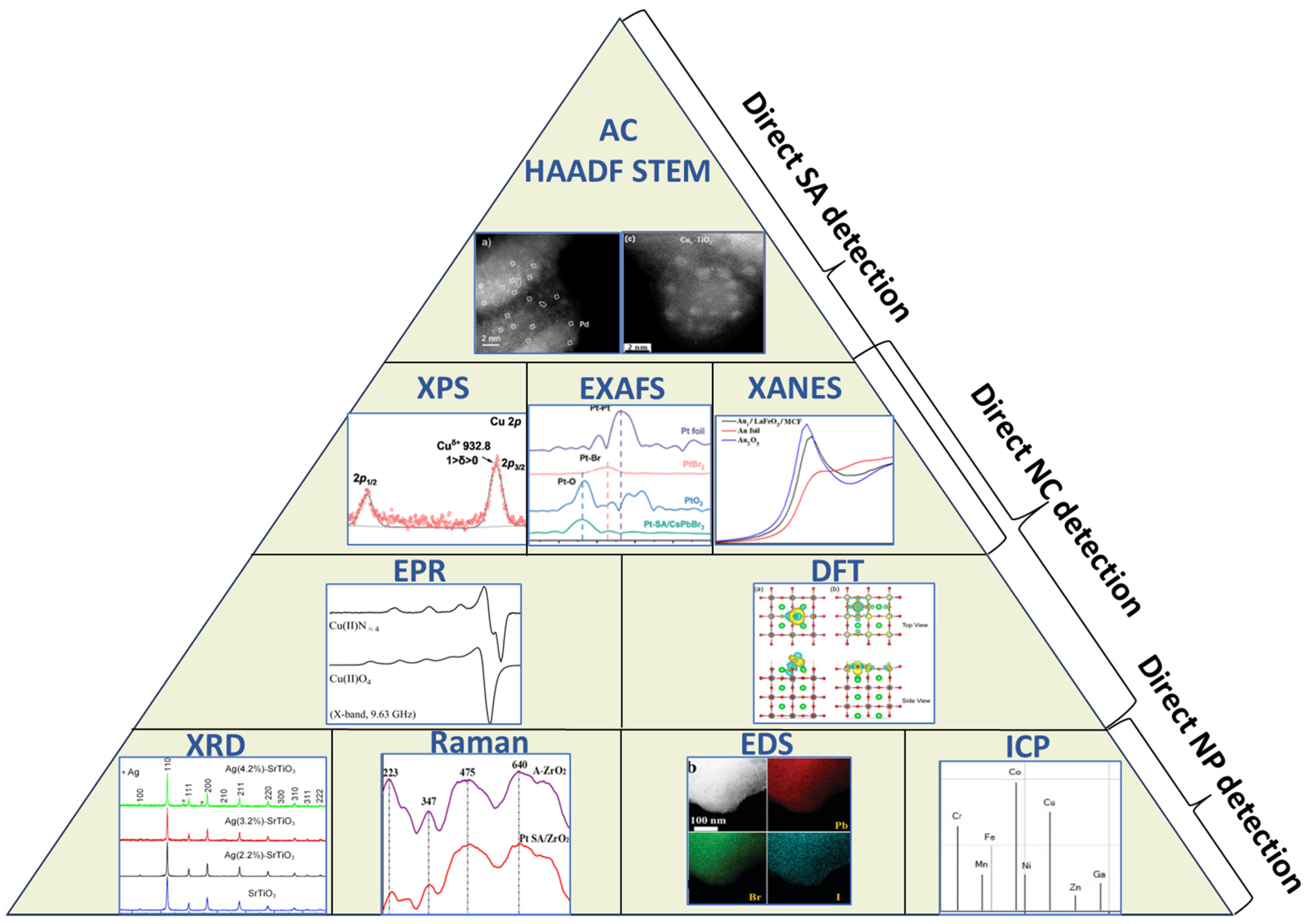
3.2. Direct Characterization of SACCs
4. Single Atoms/Sub-Nanoclusters and Quantum-Sized Small Particles of Co-Catalysts on Perovskite Oxide and Non-Perovskite Oxide Substrates
4.1. Single Atoms/Sub-Nanoclusters and Quantum-Sized Small Particles of Co-Catalysts on Perovskite Oxide
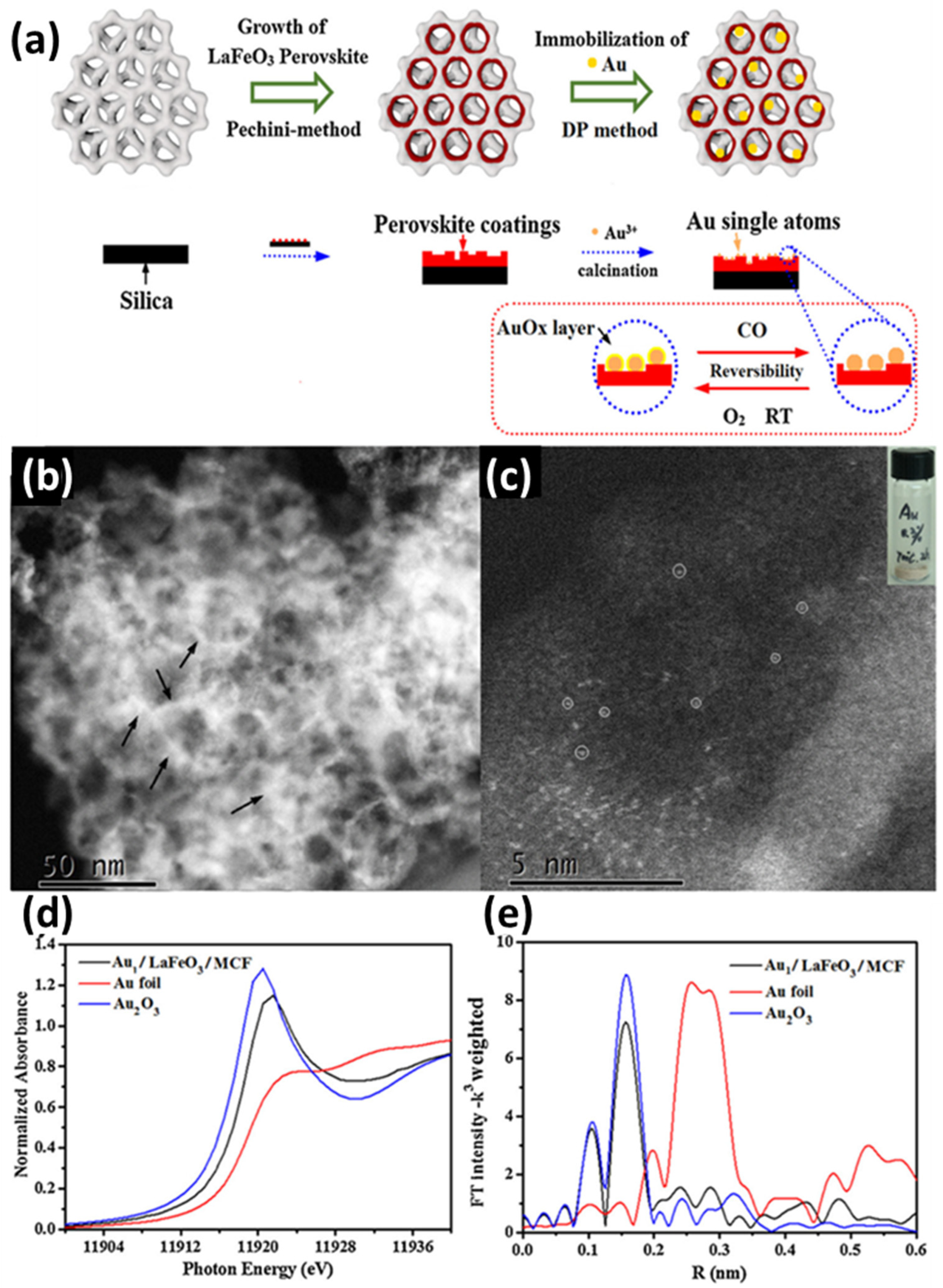
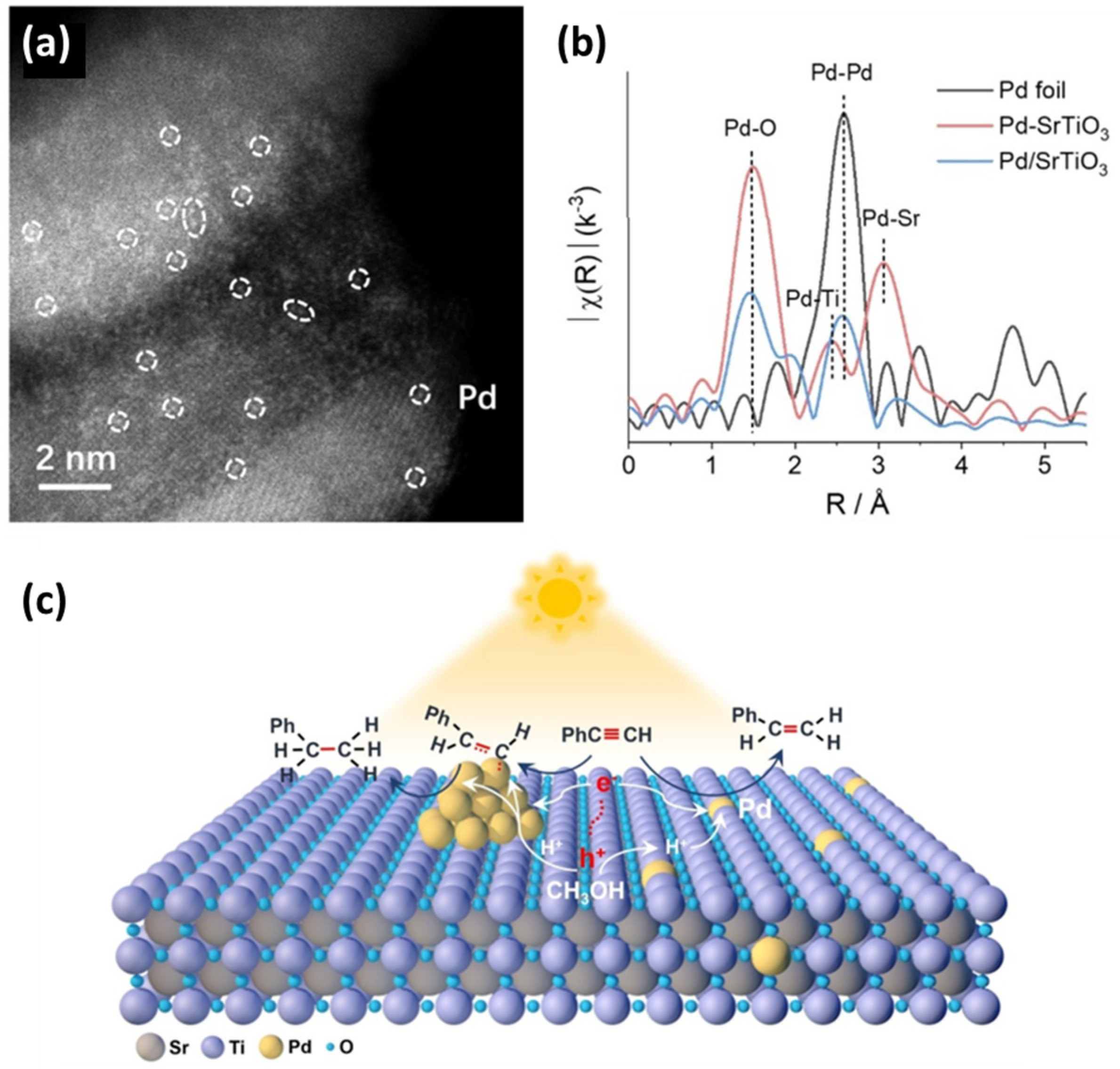
4.2. Single Atom/Sub-Nanoclusters and Quantum-Sized Small Particles of Co-Catalyst on Non-Perovskite Oxide
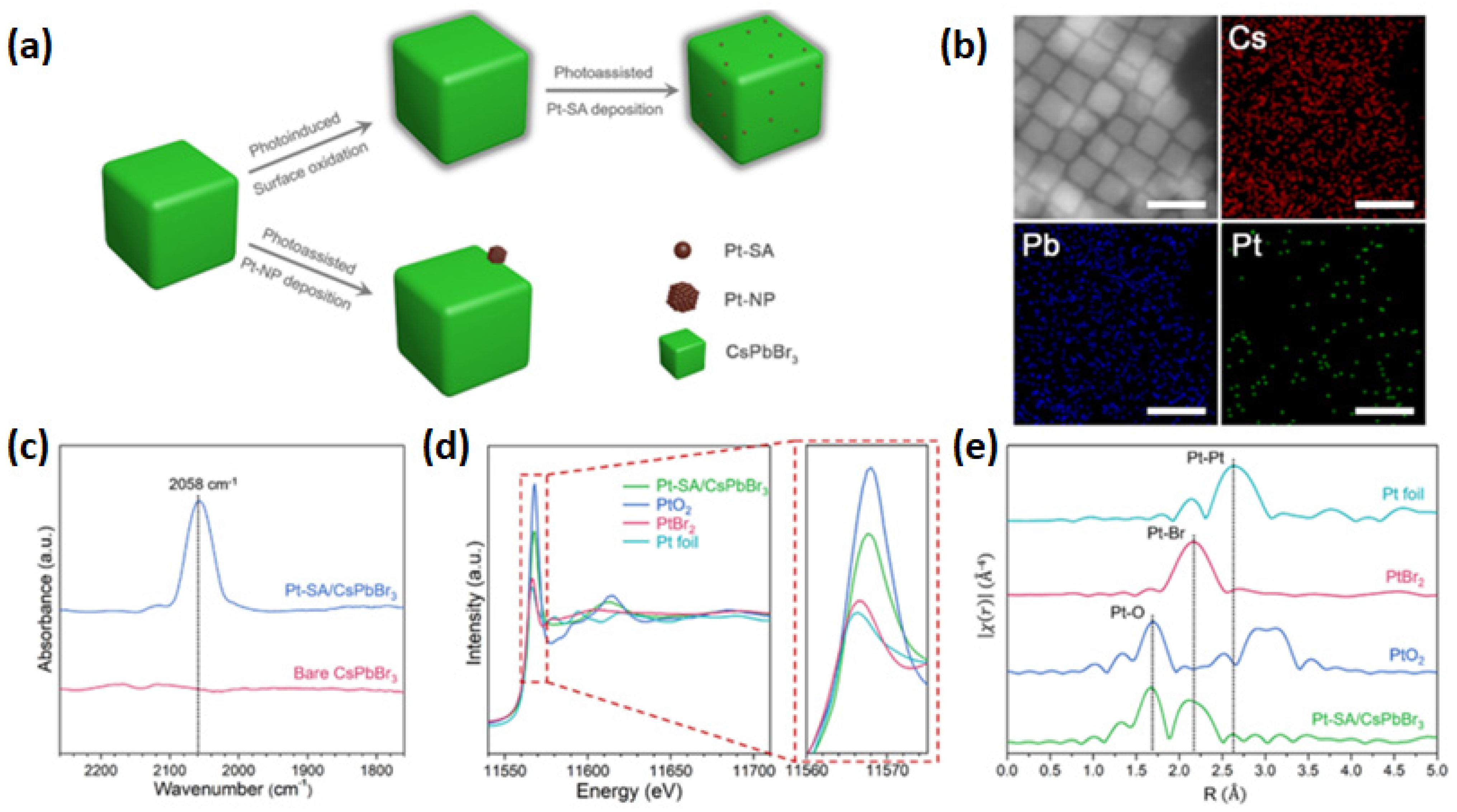
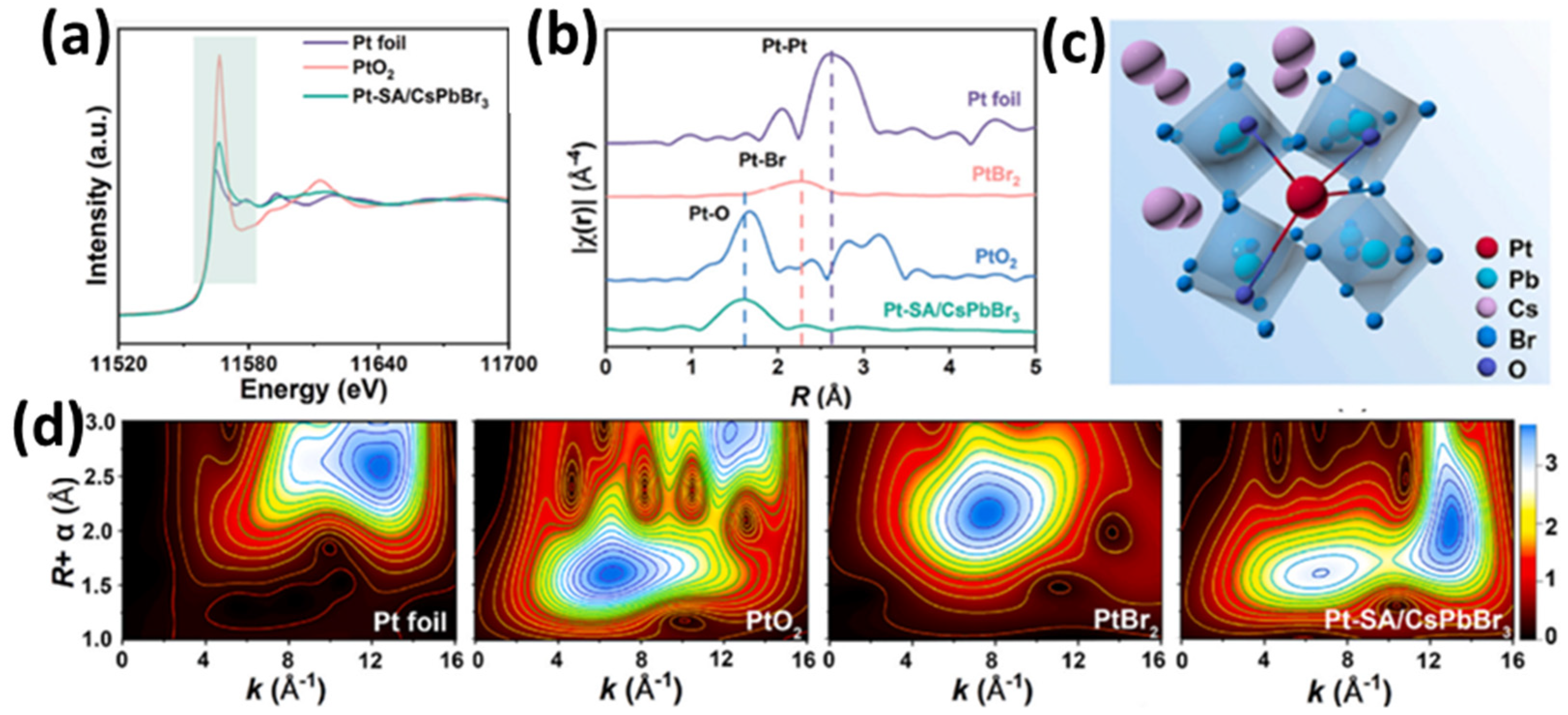
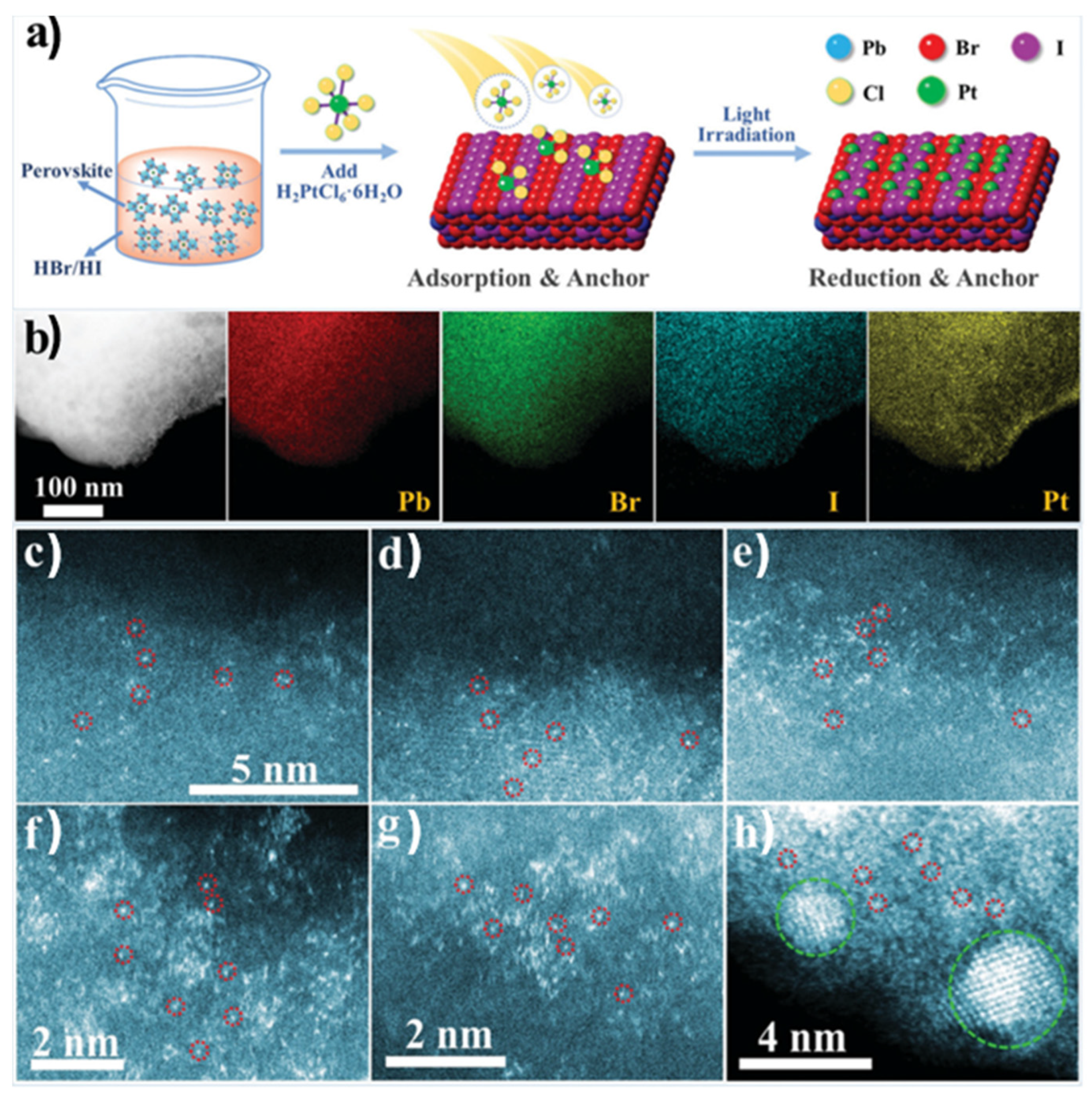
4.3. Single Atoms/Sub-Nanoclusters and Quantum-Sized Small Particles (QSSPs) of Co-Catalyst on Metal Oxides
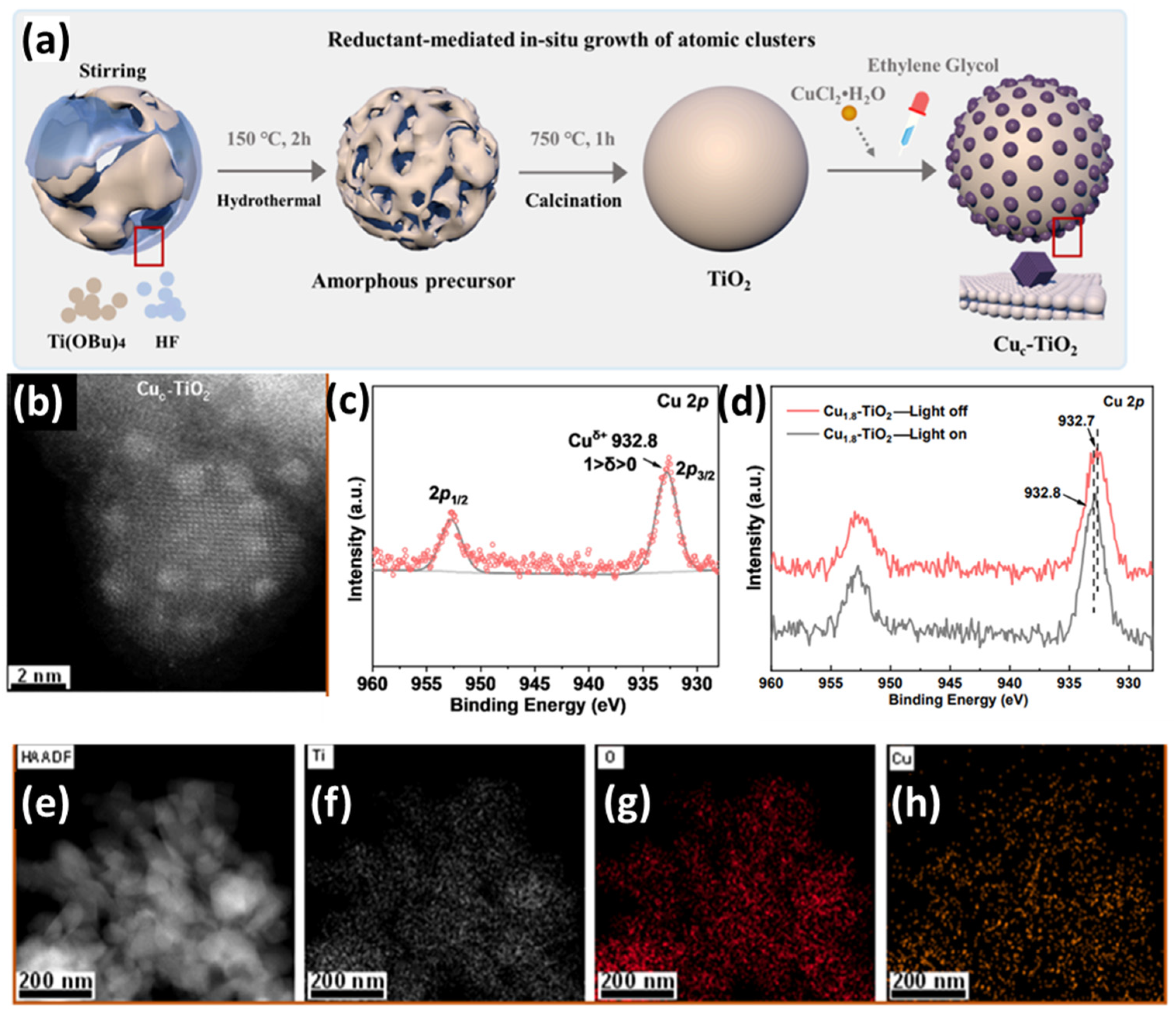

| Nanostructure | Co-Catalyst | Aggregation State of the Co-Catalyst | Method of Analysis | Catalytic Application | Ref. |
|---|---|---|---|---|---|
| Perovskites | |||||
| LaFeO3 | Au | SACs | HAADF-STEM, EDS, XAFS, DFT, EXAFS, XANES | CO oxidation | [68] |
| SrBO3 (B = 3d transition metals) | Pt | SACs | DFT | Methane activation | [109] |
| CsPbBr3 | Pt | SACs, NPs | HR-TEM, 3D-FP XANES, EXAFS | Photocatalytic semi-hydrogenation of propyne | [89] |
| SrTiO3 | Pt | SACs, SNCs, NPs | HAADF-STEM, EXAFS | Reverse water–gas shift reactions | [87] |
| Cs2SnI6 | Pt | SACs, NPs | HAADF-STEM, EDS, XAFS, XPS, EXAFS, EXANS, DFT | Photocatalytic hydrogen production | [88] |
| CsPbBr3 | Pt | SACs | HAADF-STEM, EDS, XPS, DRIFT, EXAFS, XANES | Electrochemical sensing of ascorbic acid | [86] |
| FAPbBr3−xIx (FA = CH(NH2)2) | Pt | SACs | HAADF-STEM, EDS, XPS, DFT, EXAFS, XANES | Photocatalytic hydrogen production | [90] |
| LaCoO3 | Pt | SACs, SNCs | HAADF-STEM, EDS, EXAFS, EPR, XANES, XPS | Chemiresistive sensing of acetone gas | [91] |
| NaTaO3 | Ni | NPs | TEM, XRD, BET | Photocatalytic hydrogen production | [73] |
| SrTiO3 | Ni | SACs, SNCs | STEM, PES, DFT | - | [92] |
| BiFeO3 | Co | SACs | AC HAADF-STEM, EDX, XPS, XANES, EXAFS | Photocatalytic oxygen evolution | [93] |
| SrTiO3 | Pd | SACs, SNCs | AC HAADF-STEM, XAS, XPS, XANES | Photocatalytic semihydrogenation of Alkynes | [94] |
| SrTiO3 | Au | SACs | STEM-MBE/RHEED/LEED | - | [95] |
| Metal Oxides | |||||
| TiO2 | Cu | SACs | HAADF-STEM, EDS, PL, UV-vis, XPS, FTIR, SPV, fs-TAS, EPR, ICP, DFT | Photocatalytic hydrogen production | [96] |
| TiO2 | Cu | SNCs | HAADF-STEM, EDS, XPS, ICP, UV-vis, PL, TRPL | Photocatalytic hydrogen production | [97] |
| TiO2 | Pd | SACs | STEM, XPS, EPR | - | [71] |
| ZrO2 | Ni | SACs, SNCs | AC HAADF-STEM, XANES, EXAFS, XPS, DFT | Photocatalytic CO2 Reduction to CO | [98] |
| ZrO2 | Pt | SACs | AC-TEM, EDS, ICP, XANES, EXAFS, XPS, Raman | Photocatalytic CO2 Reduction to CO | [99] |
5. Concluding Remarks—Future Perspectives
Funding
Data Availability Statement
Conflicts of Interest
References
- Nosaka, Y.; Nosaka, A. Introduction to Photocatalysis: From Basic Science to Applications; Royal Society of Chemistry: London, UK, 2016. [Google Scholar] [CrossRef]
- Hassaan, M.A.; El-Nemr, M.A.; Elkatory, M.R.; Ragab, S.; Niculescu, V.-C.; El Nemr, A. Principles of Photocatalysts and Their Different Applications: A Review. Top. Curr. Chem. 2023, 381, 31. [Google Scholar] [CrossRef] [PubMed]
- Karakaş, İ.H.; Karakaş, Z.K. Emerging trends and future prospects in photocatalysis-based environmental remediation and hydrogen production. In Photocatalysts for Energy and Environmental Sustainability; IOP Publishing: Bristol, UK, 2024; pp. 7–24. [Google Scholar] [CrossRef]
- Ahmad, K.; Ghatak, H.; Ahuja, S. Photocatalytic Technology: A review of environmental protection and renewable energy application for sustainable development. Environ. Technol. Innov. 2020, 19, 100893. [Google Scholar] [CrossRef]
- Yang, J.; Wang, D.; Han, H.; Li, C. Roles of Cocatalysts in Photocatalysis and Photoelectrocatalysis. Acc. Chem. Res. 2013, 46, 1900–1909. [Google Scholar] [CrossRef] [PubMed]
- Li, Y.; Tsang, S.C.E. Recent progress and strategies for enhancing photocatalytic water splitting. Mater. Today Sustain. 2020, 9, 100032. [Google Scholar] [CrossRef]
- Chu, S.; Wang, E.; Feng, F.; Zhang, C.; Jiang, J.; Zhang, Q.; Wang, F.; Bing, L.; Wang, G.; Han, D. A Review of Noble Metal Catalysts for Catalytic Removal of VOCs. Catalysts 2022, 12, 1543. [Google Scholar] [CrossRef]
- Zhao, G.; Xu, X. Cocatalysts from types{,} preparation to applications in the field of photocatalysis. Nanoscale 2021, 13, 10649–10667. [Google Scholar] [CrossRef]
- Jiang, X.; Tang, L.; Dong, L.; Sheng, X.; Zhang, W.; Liu, Z.; Shen, J.; Jiang, H.; Li, C. Cu Single-Atom Catalysts for High-Selectivity Electrocatalytic Acetylene Semihydrogenation. Angew. Chemie Int. Ed. 2023, 62, e202307848. [Google Scholar] [CrossRef] [PubMed]
- Millet, M.-M.; Algara-Siller, G.; Wrabetz, S.; Mazheika, A.; Girgsdies, F.; Teschner, D.; Seitz, F.; Tarasov, A.; Levchenko, S.V.; Schlögl, R.; et al. Ni Single Atom Catalysts for CO2 Activation. J. Am. Chem. Soc. 2019, 141, 2451–2461. [Google Scholar] [CrossRef] [PubMed]
- Zhao, Q.; Yao, W.; Huang, C.; Wu, Q.; Xu, Q. Effective and Durable Co Single Atomic Cocatalysts for Photocatalytic Hydrogen Production. ACS Appl. Mater. Interfaces 2017, 9, 42734–42741. [Google Scholar] [CrossRef]
- Li, M.; He, C.; Yang, X.; Liu, Z.; Li, J.; Wang, L.; Wu, S.; Zhang, J. Optimizing water dissociation dehydrogenation process via Sn single atom incorporation for boosting photocatalytic CO2 methanation. Chem Catal. 2023, 3, 100737. [Google Scholar] [CrossRef]
- Mitchell, S.; Pérez-Ramírez, J. Single atom catalysis: A decade of stunning progress and the promise for a bright future. Nat. Commun. 2020, 11, 4302. [Google Scholar] [CrossRef]
- Qiao, B.; Wang, A.; Yang, X.; Allard, L.F.; Jiang, Z.; Cui, Y.; Liu, J.; Li, J.; Zhang, T. Single-atom catalysis of CO oxidation using Pt1/FeOx. Nat. Chem. 2011, 3, 634–641. [Google Scholar] [CrossRef]
- Xing, J.; Chen, J.F.; Li, Y.H.; Yuan, W.T.; Zhou, Y.; Zheng, L.R.; Wang, H.F.; Hu, P.; Wang, Y.; Zhao, H.J.; et al. Stable Isolated Metal Atoms as Active Sites for Photocatalytic Hydrogen Evolution. Chem.—A Eur. J. 2014, 20, 2138–2144. [Google Scholar] [CrossRef]
- He, H.; Wang, H.; Liu, J.; Liu, X.; Li, W.; Wang, Y. Research Progress and Application of Single-Atom Catalysts: A Review. Molecules 2021, 26, 6501. [Google Scholar] [CrossRef] [PubMed]
- Han, B.; Guo, Y.; Huang, Y.; Xi, W.; Xu, J.; Luo, J.; Qi, H.; Ren, Y.; Liu, X.; Qiao, B.; et al. Strong Metal–Support Interactions between Pt Single Atoms and TiO2. Angew. Chemie Int. Ed. 2020, 59, 11824–11829. [Google Scholar] [CrossRef]
- Liu, Y.; Bai, S.; Li, Q.; Wu, Z.; Shen, T.; Chu, J.; Song, Y.-F. Recent progress on atomic-scale modulation of single-atom-based catalysts for electrocatalytic CO2 reduction. Chem. Eng. J. 2023, 477, 146610. [Google Scholar] [CrossRef]
- Liu, L.; Chen, T.; Chen, Z. Understanding the Dynamic Aggregation in Single-Atom Catalysis. Adv. Sci. 2024, 11, 2308046. [Google Scholar] [CrossRef] [PubMed]
- He, T.; Santiago, A.R.; Kong, Y.; Ahsan, M.A.; Luque, R.; Du, A.; Pan, H. Atomically Dispersed Heteronuclear Dual-Atom Catalysts: A New Rising Star in Atomic Catalysis. Small 2021, 18, 2106091. [Google Scholar] [CrossRef] [PubMed]
- Liu, L.; Zheng, S. Advancements in Single Atom Catalysts for Electrocatalytic Nitrate Reduction Reaction. ChemCatChem 2024, 16, e202301641. [Google Scholar] [CrossRef]
- Liu, L.; Corma, A. Metal Catalysts for Heterogeneous Catalysis: From Single Atoms to Nanoclusters and Nanoparticles. Chem. Rev. 2018, 118, 4981–5079. [Google Scholar] [CrossRef] [PubMed]
- Chen, Y.; Lin, J.; Jia, B.; Wang, X.; Jiang, S.; Ma, T. Isolating Single and Few Atoms for Enhanced Catalysis. Adv. Mater. 2022, 34, e2201796. [Google Scholar] [CrossRef] [PubMed]
- Kumar, P.; Khan, M.; Hu, J.; Kibria, M. Single-atom catalysts for biomass-derived drop-in chemicals. In Advanced Catalysis for Drop-in Chemicals; Elsevier: Amsterdam, The Netherlands, 2022; pp. 63–100. [Google Scholar] [CrossRef]
- Cai, J.; Javed, R.; Ye, D.; Zhao, H.; Zhang, J. Recent progress in noble metal nanocluster and single atom electrocatalysts for the hydrogen evolution reaction. J. Mater. Chem. A 2020, 8, 22467–22487. [Google Scholar] [CrossRef]
- Zhang, X.; Liu, Y.; Ma, X.; Liu, X.; Zhang, R.; Wang, Y. Metal–Support Interaction of Carbon–Based Electrocatalysts for Oxygen Evolution Reaction. Nanoenergy Adv. 2023, 3, 48–72. [Google Scholar] [CrossRef]
- Efros, A.L.; Brus, L.E. Nanocrystal Quantum Dots: From Discovery to Modern Development. ACS Nano 2021, 15, 6192–6210. [Google Scholar] [CrossRef] [PubMed]
- Takaaki, T.; Hiroyuki, H.; Martin, V.; Tomoyasu, T. Nanoscale Physics for Materials Science; Taylor & Francis Group: Abingdon, UK, 2010. [Google Scholar]
- Yang, X.-F.; Wang, A.; Qiao, B.; Li, J.; Liu, J.; Zhang, T. Single-Atom Catalysts: A New Frontier in Heterogeneous Catalysis. Acc. Chem. Res. 2013, 46, 1740–1748. [Google Scholar] [CrossRef] [PubMed]
- Zhang, D.; Li, Y.; Li, Y.; Zhan, S. Towards single-atom photocatalysts for future carbon-neutral application. SmartMat 2022, 3, 417–446. [Google Scholar] [CrossRef]
- Guo, J.; Liu, H.; Li, D.; Wang, J.; Djitcheu, X.; He, D.; Zhang, Q. A minireview on the synthesis of single atom catalysts. RSC Adv. 2022, 12, 9373–9394. [Google Scholar] [CrossRef] [PubMed]
- Chen, T.; Ye, L.; Lo, T.W.B. Designing the electronic and geometric structures of single-atom and nanocluster catalysts. J. Mater. Chem. A 2021, 9, 18773–18784. [Google Scholar] [CrossRef]
- Atomic Radius in the Periodic Table of Elements. Available online: https://pubchem.ncbi.nlm.nih.gov/ptable/atomic-radius/ (accessed on 14 January 2025).
- Atomic Mass in the Periodic Table of Elements. Available online: https://pubchem.ncbi.nlm.nih.gov/ptable/atomic-mass/ (accessed on 14 January 2025).
- Sun, N.; Song, J.; Tao, Q.; Kan, E.; Kuai, L. High-loading single-atom Pt/TiO2 mesoporous catalysts for superior photocatalytic oxidation of benzyl alcohol. Microporous Mesoporous Mater. 2022, 337, 111949. [Google Scholar] [CrossRef]
- Luo, J.; Waterhouse, G.I.N.; Peng, L.; Chen, Q. Recent progress in high-loading single-atom catalysts and their applications. Ind. Chem. Mater. 2023, 1, 486–500. [Google Scholar] [CrossRef]
- Shi, R.; Tian, C.; Zhu, X.; Peng, C.-Y.; Mei, B.; He, L.; Du, X.-L.; Jiang, Z.; Chen, Y.; Dai, S. Achieving an exceptionally high loading of isolated cobalt single atoms on a porous carbon matrix for efficient visible-light-driven photocatalytic hydrogen production. Chem. Sci. 2019, 10, 2585–2591. [Google Scholar] [CrossRef] [PubMed]
- Lazaar, N.; Wu, S.; Qin, S.; Hamrouni, A.; Bikash Sarma, B.; Doronkin, D.E.; Denisov, N.; Lachheb, H.; Schmuki, P. Single-Atom Catalysts on C3N4: Minimizing Single Atom Pt Loading for Maximized Photocatalytic Hydrogen Production Efficiency. Angew. Chemie Int. Ed. 2025, 64, e202416453. [Google Scholar] [CrossRef]
- Qin, S.; Will, J.; Kim, H.; Denisov, N.; Carl, S.; Spiecker, E.; Schmuki, P. Single Atoms in Photocatalysis: Low Loading Is Good Enough! ACS Energy Lett. 2023, 8, 1209–1214. [Google Scholar] [CrossRef]
- Wu, S.-M.; Schmuki, P. Single Atom Cocatalysts in Photocatalysis. Adv. Mater. 2024, 2414889. [Google Scholar] [CrossRef]
- Peña, M.A.; Fierro, J.L.G. Chemical Structures and Performance of Perovskite Oxides. Chem. Rev. 2021, 101, 1981–2018. [Google Scholar] [CrossRef] [PubMed]
- Tilley, R.J.D. The ABX3 Perovskite Structure. In Perovskites; John Wiley & Sons, Ltd.: Hoboken, NJ, USA, 2016; pp. 1–41. [Google Scholar] [CrossRef]
- Grabowska, E. Selected perovskite oxides: Characterization, preparation and photocatalytic properties—A review. Appl. Catal. B Environ. 2016, 186, 97–126. [Google Scholar] [CrossRef]
- Wang, R.; He, B.; Wang, D.; Jia, C.; Cao, J.; Shi, L.; Pan, J.; Hai, G.; Li, C. Dual functional high entropy perovskite La(Mn0.2Cr0.2Fe0.2Co0.2Ni0.2)O3 interfacial transition layer modified Cu2Y2O5/CdIn2O4 transparent pn junction towards photovoltaic enhancement. Ceram. Int. 2024, 50, 52917–52926. [Google Scholar] [CrossRef]
- Wang, Y.; He, L.; Li, W. Morphology effect of nano-hydroxyapatite as support for loading Ni in methane dry reforming. J. Fuel Chem. Technol. 2023, 51, 977–985. [Google Scholar] [CrossRef]
- Du, D.; He, H.; Zheng, R.; Zeng, L.; Wang, X.; Shu, C.; Zhang, C. Single-Atom Immobilization Boosting Oxygen Redox Kinetics of High-Entropy Perovskite Oxide Toward High-Performance Lithium-Oxygen Batteries. Adv. Energy Mater. 2024, 14, 2304238. [Google Scholar] [CrossRef]
- Seong, A.; Kwon, O.; Kim, K.; Lee, J.H.; Gorte, R.; Vohs, J.; Han, J.W.; Kim, G. Highly active dry methane reforming catalysts with boosted in situ grown Ni-Fe nanoparticles on perovskite via atomic layer deposition. Sci. Adv. 2020, 6, eabb1573. [Google Scholar] [CrossRef]
- Irshad, M.; Ain, Q.T.; Zaman, M.; Aslam, M.Z.; Kousar, N.; Asim, M.; Rafique, M.; Siraj, K.; Tabish, A.N.; Usman, M.; et al. Photocatalysis and perovskite oxide-based materials: A remedy for a clean and sustainable future. RSC Adv. 2022, 12, 7009–7039. [Google Scholar] [CrossRef]
- Lamhani, M.; Chchiyai, Z.; Elomrani, A.; Manoun, B.; Hasnaoui, A. Enhanced Photocatalytic Water Splitting of SrTiO3 Perovskite through Cobalt Doping: Experimental and Theoretical DFT Understanding. Inorg. Chem. 2023, 62, 13405–13418. [Google Scholar] [CrossRef] [PubMed]
- Lyu, H.; Hisatomi, T.; Goto, Y.; Yoshida, M.; Higashi, T.; Katayama, M.; Takata, T.; Minegishi, T.; Nishiyama, H.; Yamada, T.; et al. An Al-doped SrTiO3 photocatalyst maintaining sunlight-driven overall water splitting activity for over 1000 h of constant illumination. Chem. Sci. 2019, 10, 3196–3201. [Google Scholar] [CrossRef] [PubMed]
- Dylla, M.; Kang, S.; Snyder, J. Effect of Two-Dimensional Crystal Orbitals on Fermi Surfaces and Electron Transport in Three-Dimensional Perovskite Oxides. Angew. Chemie Int. Ed. 2019, 58, 5503–5512. [Google Scholar] [CrossRef] [PubMed]
- Li, Y.; Yang, Y.; Shu, X.; Wan, D.; Wei, N.; Yu, X.; Breese, M.; Venkatesan, T.; Xue, J.; Liu, Y.; et al. From Titanium Sesquioxide to Titanium Dioxide: Oxidation-Induced Structural, Phase and Property Evolution. Chem. Mater. 2018, 30, 4383–4392. [Google Scholar] [CrossRef]
- Queisser, H.J.; Haller, E.E. Defects in Semiconductors: Some Fatal, Some Vital. Science 1998, 281, 945–950. [Google Scholar] [CrossRef] [PubMed]
- Van Benthem, K.; Elsässer, C.; French, R.H. Bulk electronic structure of SrTiO3: Experiment and theory. J. Appl. Phys. 2001, 90, 6156–6164. [Google Scholar] [CrossRef]
- Ikeue, K.; Yamamoto, Y.; Suzuki, M. Photocatalytic Activity for Hydrogen Evolution of Heteroatom-Doped SrTiO3 Prepared Using a Graphitic-Carbon Nitride Nanosheet. Ceramics 2020, 3, 22–30. [Google Scholar] [CrossRef]
- Park, N.-H.; Dang, F.; Wan, C.; Seo, W.-S.; Koumoto, K. Self-originating two-step synthesis of core–shell structured La-doped SrTiO3 nanocubes. J. Asian Ceram. Soc. 2013, 1, 35–40. [Google Scholar] [CrossRef]
- Eng, H.; Barnes, P.; Auer, B.; Woodward, P. Investigation of the Electronic Structure of d0 Transition Metal Oxides Belonging to the Perovskite Family. J. Solid State Chem. 2003, 175, 94–109. [Google Scholar] [CrossRef]
- Yadav, P.; Yadav, S.; Atri, S.; Tomar, R. A Brief Review on Key Role of Perovskite Oxides as Catalyst. ChemistrySelect 2021, 6, 12947–12959. [Google Scholar] [CrossRef]
- Kawawaki, T.; Mori, Y.; Wakamatsu, K.; Ozaki, S.; Kawachi, M.; Hossain, S.; Negishi, Y. Controlled colloidal metal nanoparticles and nanoclusters: Recent applications as cocatalysts for improving photocatalytic water-splitting activity. J. Mater. Chem. A 2020, 8, 16081–16113. Available online: https://api.semanticscholar.org/CorpusID:225383963 (accessed on 11 December 2024). [CrossRef]
- Pawar, G.S.; Tahir, A.A. Unbiased Spontaneous Solar Fuel Production using Stable LaFeO3 Photoelectrode. Sci. Rep. 2018, 8, 3501. [Google Scholar] [CrossRef]
- Sathiyamoorthy, K.; Silambarasan, A.; Navaneethan, M.; Harish, S. Boosting the performance of LaCoO3/MoS2 perovskite interface for sustainable decontaminants under visible light-driven photocatalysis. Chemosphere 2024, 348, 140575. [Google Scholar] [CrossRef] [PubMed]
- Yeh, K.-C.; Chan, C.-H. High brightness and low operating voltage CsPbBr3 perovskite LEDs by single-source vapor deposition. Sci. Rep. 2024, 14, 3351. [Google Scholar] [CrossRef]
- Zhang, G.; Zhang, J.; Liao, Y.; Pan, Z.; Rao, H.; Zhong, X. Cs2SnI6 nanocrystals enhancing hole extraction for efficient carbon-based CsPbI2Br perovskite solar cells. Chem. Eng. J. 2022, 440, 135710. [Google Scholar] [CrossRef]
- Man, S.; Leng, X.; Bai, J.; Kan, S.; Cui, Y.; Wang, J.; Xu, L. Enhancement of photoelectrochemical performance of BiFeO3 by Sm3+ doping. Ceram. Int. 2023, 49, 10255–10264. [Google Scholar] [CrossRef]
- Yang, H.; Liu, Y.; Ding, Y.; Li, F.; Wang, L.; Cai, B.; Zhang, F.; Liu, T.; Boschloo, G.; Johansson, E.M.J.; et al. Monolithic FAPbBr3 photoanode for photoelectrochemical water oxidation with low onset-potential and enhanced stability. Nat. Commun. 2023, 14, 5486. [Google Scholar] [CrossRef]
- Gaggero, E.; Calza, P.; Cerrato, E.; Paganini, M.C. Cerium-, Europium- and Erbium-Modified ZnO and ZrO2 for Photocatalytic Water Treatment Applications: A Review. Catalysts 2021, 11, 1520. [Google Scholar] [CrossRef]
- Temerov, F.; Baghdadi, Y.; Rattner, E.; Eslava, S. A Review on Halide Perovskite-Based Photocatalysts: Key Factors and Challenges. ACS Appl. Energy Mater. 2022, 5, 14605–14637. [Google Scholar] [CrossRef]
- Tian, C.; Zhang, H.; Zhu, X.; Lin, B.; Liu, X.; Chen, H.; Zhang, Y.; Mullins, D.R.; Abney, C.W.; Shakouri, M.; et al. A new trick for an old support: Stabilizing gold single atoms on LaFeO3 perovskite. Appl. Catal. B Environ. 2020, 261, 118178. [Google Scholar] [CrossRef]
- Onn, T.M.; Monai, M.; Dai, S.; Fonda, E.; Montini, T.; Pan, X.; Graham, G.W.; Fornasiero, P.; Gorte, R.J. Smart Pd Catalyst with Improved Thermal Stability Supported on High-Surface-Area LaFeO3 Prepared by Atomic Layer Deposition. J. Am. Chem. Soc. 2018, 140, 4841–4848. [Google Scholar] [CrossRef] [PubMed]
- Vidal-Iglesias, F.J.; Solla-Gullón, J.; Rodes, A.; Herrero, E.; Aldaz, A. Understanding the Nernst Equation and Other Electrochemical Concepts: An Easy Experimental Approach for Students. J. Chem. Educ. 2012, 89, 936–939. [Google Scholar] [CrossRef]
- Stathi, P.; Belles, L.; Deligiannakis, Y. Multipotent Atomic Palladium Species Pd1+, Pd2+–O2–, and Pd3+ Formed at the Interface of Pd/TiO2 Nanoparticles: Electron Paramagnetic Resonance Study. J. Phys. Chem. C 2022, 126, 14125–14137. [Google Scholar] [CrossRef]
- Stathi, P.; Solakidou, M.; Zindrou, A.; Belles, L.; Deligiannakis, Y. Atomic {Pdn+-X} States at Nanointerfaces: Implications in Energy-Related Catalysis. Energies 2023, 16, 913. [Google Scholar] [CrossRef]
- Psathas, P.; Zindrou, A.; Spyrou, A.V.; Deligiannakis, Y. Engineering of LiTaO3 Nanoparticles by Flame Spray Pyrolysis: Understanding In Situ Li-Incorporation into the Ta2O5 Lattice. Nanomaterials 2024, 14, 1257. [Google Scholar] [CrossRef]
- Psathas, P.; Moularas, C.; Smykała, S.; Deligiannakis, Y. Highly Crystalline Nanosized NaTaO3/NiO Heterojunctions Engineered by Double-Nozzle Flame Spray Pyrolysis for Solar-to-H2 Conversion: Toward Industrial-Scale Synthesis. ACS Appl. Nano Mater. 2023, 6, 2658–2671. [Google Scholar] [CrossRef]
- Cheng, N.; Zhang, L.; Doyle-Davis, K.; Sun, X. Single-Atom Catalysts: From Design to Application. Electrochem. Energy Rev. 2019, 2, 539–573. [Google Scholar] [CrossRef]
- Wang, A.; Li, J.; Zhang, T. Heterogeneous single-atom catalysis. Nat. Rev. Chem. 2018, 2, 65–81. [Google Scholar] [CrossRef]
- Chang, T.-Y.; Tanaka, Y.; Ishikawa, R.; Toyoura, K.; Matsunaga, K.; Ikuhara, Y.; Shibata, N. Direct Imaging of Pt Single Atoms Adsorbed on TiO2 (110) Surfaces. Nano Lett. 2014, 14, 134–138. [Google Scholar] [CrossRef] [PubMed]
- Hejazi, S.; Mohajernia, S.; Osuagwu, B.; Zoppellaro, G.; Andryskova, P.; Tomanec, O.; Kment, S.; Zbořil, R.; Schmuki, P. On the Controlled Loading of Single Platinum Atoms as a Co-Catalyst on TiO2 Anatase for Optimized Photocatalytic H2 Generation. Adv. Mater. 2020, 32, 1908505. [Google Scholar] [CrossRef]
- Li, S.; Xin, Z.; Luo, Y.; Pan, J.; Liao, G.; Li, Q.; Sun, Y.; Feng, Z.; Tan, R. Recent advances in the development of single atom catalysts for oxygen evolution reaction. Int. J. Hydrogen Energy 2024, 82, 1081–1100. [Google Scholar] [CrossRef]
- Wang, C.; Najimu, M.; Ko, B.; Sasmaz, E. Impact of Flame Conditions on the Pd-O Structure and Methane Oxidation Activity over Ceria Support. ChemCatChem 2024, 17, e202401449. [Google Scholar] [CrossRef]
- Zhang, H.; Liu, W.; Cao, D.; Cheng, D. Carbon-based material-supported single-atom catalysts for energy conversion. iScience 2022, 25, 104367. [Google Scholar] [CrossRef]
- Kaiser, S.K.; Chen, Z.; Akl, D.F.; Mitchell, S.; Pérez-Ramírez, J. Single-Atom Catalysts across the Periodic Table. Chem. Rev. 2020, 120, 11703–11809. [Google Scholar] [CrossRef] [PubMed]
- Fonseca, J.; Lu, J. Single-Atom Catalysts Designed and Prepared by the Atomic Layer Deposition Technique. ACS Catal. 2021, 11, 7018–7059. [Google Scholar] [CrossRef]
- Cheng, N.; Sun, X. Single atom catalyst by atomic layer deposition technique. Chinese J. Catal. 2017, 38, 1508–1514. [Google Scholar] [CrossRef]
- Butburee, T.; Ponchai, J.; Khemthong, P.; Mano, P.; Chakthranont, P.; Youngjan, S.; Phanthasri, J.; Namuangruk, S.; Faungnawakij, K.; Wang, X.; et al. General Pyrolysis for High-Loading Transition Metal Single Atoms on 2D-Nitro-Oxygeneous Carbon as Efficient ORR Electrocatalysts. ACS Appl. Mater. Interfaces 2024, 16, 10227–10237. [Google Scholar] [CrossRef]
- Qin, Y.; Chen, H.; Luo, Y.; Zhang, J.; Zhou, K.; Leng, Y.; Zheng, J.; Chen, Z. Platinum single atom on CsPbBr3 nanocrystals as electrocatalyst boosts electrochemical sensing of ascorbic acid. Talanta 2024, 277, 126396. [Google Scholar] [CrossRef]
- Xing, Y.; Ouyang, M.; Zhang, L.; Yang, M.; Wu, X.; Ran, R.; Weng, D.; Kang, F.; Si, Z. Single Atomic Pt on SrTiO3 Catalyst in Reverse Water Gas Shift Reactions. Catalysts 2021, 11, 738. [Google Scholar] [CrossRef]
- Zhou, P.; Chen, H.; Chao, Y.; Zhang, Q.; Zhang, W.; Lv, F.; Gu, L.; Zhao, Q.; Wang, N.; Wang, J.; et al. Single-atom Pt-I3 sites on all-inorganic Cs2SnI6 perovskite for efficient photocatalytic hydrogen production. Nat. Commun. 2021, 12, 4412. [Google Scholar] [CrossRef]
- Hu, H.; Guan, W.; Xu, Y.; Wang, X.; Wu, L.; Chen, M.; Zhong, Q.; Xu, Y.; Li, Y.; Sham, T.-K.; et al. Construction of Single-Atom Platinum Catalysts Enabled by CsPbBr3 Nanocrystals. ACS Nano 2021, 15, 13129–13139. [Google Scholar] [CrossRef] [PubMed]
- Wu, Y.; Wu, Q.; Zhang, Q.; Lou, Z.; Liu, K.; Ma, Y.; Wang, Z.; Zheng, Z.; Cheng, H.; Liu, Y.; et al. An organometal halide perovskite supported Pt single-atom photocatalyst for H2 evolution. Energy Environ. Sci. 2022, 15, 1271–1281. [Google Scholar] [CrossRef]
- Shin, H.; Ko, J.; Park, C.; Kim, D.-H.; Ahn, J.; Jang, J.-S.; Kim, Y.H.; Cho, S.-H.; Baik, H.; Kim, I.-D. Sacrificial Template-Assisted Synthesis of Inorganic Nanosheets with High-Loading Single-Atom Catalysts: A General Approach. Adv. Funct. Mater. 2022, 32, 2110485. [Google Scholar] [CrossRef]
- Wang, Z.; Hao, X.; Gerhold, S.; Mares, P.; Wagner, M.; Bliem, R.; Schulte, K.; Schmid, M.; Franchini, C.; Diebold, U. Stabilizing Single Ni Adatoms on a Two-Dimensional Porous Titania Overlayer at the SrTiO3(110) Surface. J. Phys. Chem. C 2014, 118, 19904–19909. [Google Scholar] [CrossRef] [PubMed]
- Djatoubai, E.; Khan, M.S.; Haq, S.U.; Heidari, G.; Dong, C.-L.; Nga, T.T.T.; Chen, J.-L.; Shen, S. Engineered Cobalt Single-Atoms@BiFeO3 Heteronanostructures for Highly Efficient Solar Water Oxidation. Small 2023, 19, 2206293. [Google Scholar] [CrossRef]
- Yang, B.; Liu, K.; Ma, Y.; Ma, J.-J.; Chen, Y.-Y.; Huang, M.; Yang, C.; Hou, Y.; Hung, S.-F.; Yu, J.C.; et al. Incorporation of Pd Single-Atom Sites in Perovskite with an Excellent Selectivity toward Photocatalytic Semihydrogenation of Alkynes. Angew. Chemie Int. Ed. 2024, 63, e202410394. [Google Scholar] [CrossRef]
- Feng, J.; Ding, S.; Guo, J. Stable Adsorption of Single Gold Atoms on the SrTiO3(111)-(9 × 9) Reconstructed Surface. J. Phys. Chem. C 2019, 123, 4866–4870. [Google Scholar] [CrossRef]
- Zhang, Y.; Zhao, J.; Wang, H.; Xiao, B.; Zhang, W.; Zhao, X.; Lv, T.; Thangamuthu, M.; Zhang, J.; Guo, Y.; et al. Single-atom Cu anchored catalysts for photocatalytic renewable H2 production with a quantum efficiency of 56%. Nat. Commun. 2022, 13, 58. [Google Scholar] [CrossRef]
- Zou, H.; Tong, Y.; Feng, Y.; Zhou, Y.; Xiao, J.; Xia, L.; Guha, A.; Polesso, B.; Zhang, B.; Liu, J.; et al. Cu Atomic Subnanoclusters on TiO2 for Photocatalytic Hydrogen Evolution. ACS Appl. Nano Mater. 2024, 7, 11680–11689. [Google Scholar] [CrossRef]
- Xiong, X.; Mao, C.; Yang, Z.; Zhang, Q.; Waterhouse, G.I.N.; Gu, L.; Zhang, T. Photocatalytic CO2 Reduction to CO over Ni Single Atoms Supported on Defect-Rich Zirconia. Adv. Energy Mater. 2020, 10, 2002928. [Google Scholar] [CrossRef]
- Dong, S.; Liu, W.; Liu, S.; Li, F.; Hou, J.; Hao, R.; Bai, X.; Zhao, H.; Liu, J.; Guo, L. Single atomic Pt on amorphous ZrO2 nanowires for advanced photocatalytic CO2 reduction. Mater. Today Nano 2022, 17, 100157. [Google Scholar] [CrossRef]
- Shen, W. Atomically dispersed metal site in subnanometric clusters catalyze dynamically. Chem Catal. 2021, 1, 768–770. [Google Scholar] [CrossRef]
- Chen, Y.; Huang, Z.; Ma, Z.; Chen, J.; Tang, X. Fabrication{,} characterization{,} and stability of supported single-atom catalysts. Catal. Sci. Technol. 2017, 7, 4250–4258. [Google Scholar] [CrossRef]
- Liu, J.; Bunes, B.R.; Zang, L.; Wang, C. Supported single-atom catalysts: Synthesis, characterization, properties, and applications. Environ. Chem. Lett. 2018, 16, 477–505. [Google Scholar] [CrossRef]
- Liu, L.; Corma, A. Identification of the active sites in supported subnanometric metal catalysts. Nat. Catal. 2021, 4, 453–456. [Google Scholar] [CrossRef]
- Li, J.; Guan, Q.; Wu, H.; Liu, W.; Lin, Y.; Sun, Z.; Ye, X.; Zheng, X.; Pan, H.; Zhu, J.; et al. Highly Active and Stable Metal Single-Atom Catalysts Achieved by Strong Electronic Metal–Support Interactions. J. Am. Chem. Soc. 2019, 141, 14515–14519. [Google Scholar] [CrossRef] [PubMed]
- Wang, Z.; Loon, A.; Subramanian, A.; Gerhold, S.; McDermott, E.; Enterkin, J.A.; Hieckel, M.; Russell, B.C.; Green, R.J.; Moewes, A.; et al. Transition from Reconstruction toward Thin Film on the (110) Surface of Strontium Titanate. Nano Lett. 2016, 16, 2407–2412. [Google Scholar] [CrossRef]
- Van Acker, T.; Theiner, S.; Bolea-Fernandez, E.; Vanhaecke, F.; Koellensperger, G. Inductively coupled plasma mass spectrometry. Nat. Rev. Methods Prim. 2023, 3, 52. [Google Scholar] [CrossRef]
- Qi, P.; Wang, J.; Djitcheu, X.; He, D.; Liu, H.; Zhang, Q. Techniques for the characterization of single atom catalysts. RSC Adv. 2022, 12, 1216–1227. [Google Scholar] [CrossRef]
- Bennett, B.; Kowalski, J.M. Chapter Thirteen—EPR Methods for Biological Cu(II): L-Band CW and NARS. In Electron Paramagnetic Resonance Investigations of Biological Systems by Using Spin Labels, Spin Probes, and Intrinsic Metal Ions, Part A; Qin, P.Z., Warncke, K., Eds.; Academic Press: Cambridge, MA, USA, 2015; Volume 563, pp. 341–361. [Google Scholar] [CrossRef]
- Wan, Q.; Fung, V.; Lin, S.; Wu, Z.; Jiang, D. Perovskite-supported Pt single atoms for methane activation. J. Mater. Chem. A 2020, 8, 4362–4368. [Google Scholar] [CrossRef]
- Xian, T.; Yang, H.; Di, L.J.; Dai, J.F. Enhanced photocatalytic activity of SrTiO3 particles by surface decoration with Ag nanoparticles for dye degradation. Phys. Scr. 2015, 90, 55801. [Google Scholar] [CrossRef]
- Vorberg, E.; Fleischer, H.; Junginger, S.; Stoll, N.; Thurow, K. Automated sample preparation for mercury analysis in wood materials. IET Sci. Meas. Technol. 2016, 10, 398–404. [Google Scholar] [CrossRef]
- Jones, J.; Xiong, H.; DeLaRiva, A.; Peterson, E.; Phạm, H.; Challa, S.; Qi, G.; Oh, S.; Wiebenga, M.; Hernandez, X.; et al. Thermally stable single-atom platinum-on-ceria catalysts via atom trapping. Science 2016, 353, 150–154. [Google Scholar] [CrossRef]
- Liu, L.; Meira, D.M.; Arenal, R.; Concepcion, P.; Puga, A.V.; Corma, A. Determination of the Evolution of Heterogeneous Single Metal Atoms and Nanoclusters under Reaction Conditions: Which Are the Working Catalytic Sites? ACS Catal. 2019, 9, 10626–10639. [Google Scholar] [CrossRef] [PubMed]
- Rehr, J.J.; Albers, R.C. Theoretical approaches to x-ray absorption fine structure. Rev. Mod. Phys. 2000, 72, 621–654. [Google Scholar] [CrossRef]
- Zabilska, A.; Clark, A.H.; Ferri, D.; Nachtegaal, M.; Kröcher, O.; Safonova, O.V. Beware of beam damage under reaction conditions: X-ray induced photochemical reduction of supported VOx catalysts during in situ XAS experiments. Phys. Chem. Chem. Phys. 2022, 24, 21916–21926. [Google Scholar] [CrossRef]
- Tayal, A.; Coburn, D.S.; Abel, D.; Rakitin, M.; Ivashkevych, O.; Wlodek, J.; Wierzbicki, D.; Xu, W.; Nazaretski, E.; Stavitski, E.; et al. Five-analyzer Johann spectrometer for hard X-ray photon-in/photon-out spectroscopy at the Inner Shell Spectroscopy beamline at NSLS-II: Design, alignment and data acquisition. J. Synchrotron Radiat. 2024, 31, 1609–1621. [Google Scholar] [CrossRef]
- Jousseaume, T.; Colin, J.-F.; Chandesris, M.; Lyonnard, S.; Tardif, S. How Beam Damage Can Skew Synchrotron Operando Studies of Batteries. ACS Energy Lett. 2023, 8, 3323–3329. [Google Scholar] [CrossRef]
- Karak, N. Chapter 1—Fundamentals of Nanomaterials and Polymer Nanocomposites. In Nanomaterials and Polymer Nanocomposites; Karak, N., Ed.; Elsevier: Amsterdam, The Netherlands, 2019; pp. 1–45. [Google Scholar] [CrossRef]
- Karhu, H.; Kalantar, A.; Väyrynen, I.J.; Salmi, T.; Murzin, D.Y. XPS analysis of chlorine residues in supported Pt and Pd catalysts with low metal loading. Appl. Catal. A Gen. 2003, 247, 283–294. [Google Scholar] [CrossRef]
- Katrib, A.; Hemming, F.; Hilaire, L.; Wehrer, P.; Maire, G. XPS studies of supported tungsten carbide(s). J. Electron Spectros. Relat. Phenomena 1994, 68, 589–595. [Google Scholar] [CrossRef]
- Roessler, M.M.; Salvadori, E. Principles and applications of EPR spectroscopy in the chemical sciences. Chem. Soc. Rev. 2018, 47, 2534–2553. [Google Scholar] [CrossRef]
- Ju, M.; Kim, J.; Shin, J. EPR spectroscopy: A versatile tool for exploring transition metal complexes in organometallic and bioinorganic chemistry. Bull. Korean Chem. Soc. 2024, 45, 835–862. [Google Scholar] [CrossRef]
- Zollo, A.; Polliotto, V.; Livraghi, S.; Giamello, E. Self-Organisation of Copper Species at the Surface of Cu–TiO2 Systems During H2 Evolution Reaction: A Combined Investigation by EPR and Optical Spectroscopy. Appl. Magn. Reson. 2020, 51, 1497–1513. [Google Scholar] [CrossRef]
- Zhang, C.C.; Shi, J.; Hartlaub, S.; Palamara, J.P.; Petrovic, I.; Yilmaz, B. In-situ diffuse reflective infrared Fourier transform spectroscopy (DRIFTS) study on Ni passivation in FCC catalysts from boron-based technology. Catal. Commun. 2021, 150, 106273. [Google Scholar] [CrossRef]
- Fanning, P.E.; Vannice, M.A. A DRIFTS study of the formation of surface groups on carbon by oxidation. Carbon N. Y. 1993, 31, 721–730. [Google Scholar] [CrossRef]
- Kottwitz, M.; Li, Y.; Wang, H.; Frenkel, A.I.; Nuzzo, R.G. Single Atom Catalysts: A Review of Characterization Methods. Chemistry–Methods 2021, 1, 278–294. [Google Scholar] [CrossRef]
- Mistry, H.; Varela, A.S.; Kühl, S.; Strasser, P.; Cuenya, B.R. Nanostructured electrocatalysts with tunable activity and selectivity. Nat. Rev. Mater. 2016, 1, 16009. [Google Scholar] [CrossRef]
- Hasnip, P.J.; Refson, K.; Probert, M.I.J.; Yates, J.R.; Clark, S.J.; Pickard, C.J. Density functional theory in the solid state. Philos. Trans. R. Soc. A Math. Phys. Eng. Sci. 2014, 372, 20130270. [Google Scholar] [CrossRef] [PubMed]
- Erba, A.; Desmarais, J.K.; Casassa, S.; Civalleri, B.; Donà, L.; Bush, I.J.; Searle, B.; Maschio, L.; Edith-Daga, L.; Cossard, A.; et al. CRYSTAL23: A Program for Computational Solid State Physics and Chemistry. J. Chem. Theory Comput. 2023, 19, 6891–6932. [Google Scholar] [CrossRef] [PubMed]
- Gu, Q.; Pandey, S.K.; Tiwari, R. A computational method to estimate spin–orbital interaction strength in solid state systems. Comput. Mater. Sci. 2023, 221, 112090. [Google Scholar] [CrossRef]
- Tian, C.; Zhu, X.; Abney, C.W.; Liu, X.; Foo, G.S.; Wu, Z.; Li, M.; Meyer, H.M.I.I.I.; Brown, S.; Mahurin, S.M.; et al. Toward the Design of a Hierarchical Perovskite Support: Ultra-Sintering-Resistant Gold Nanocatalysts for CO Oxidation. ACS Catal. 2017, 7, 3388–3393. [Google Scholar] [CrossRef]
- Zhang, H.; Itoi, T.; Konishi, T.; Izumi, Y. Dual Photocatalytic Roles of Light: Charge Separation at the Band Gap and Heat via Localized Surface Plasmon Resonance To Convert CO2 into CO over Silver–Zirconium Oxide. J. Am. Chem. Soc. 2019, 141, 6292–6301. [Google Scholar] [CrossRef]
- Deligiannakis, Y.; Mantzanis, A.; Zindrou, A.; Smykala, S.; Solakidou, M. Control of monomeric Vo’s versus Vo clusters in ZrO2−x for solar-light H2 production from H2O at high-yield (millimoles gr−1 h−1). Sci. Rep. 2022, 12, 15132. [Google Scholar] [CrossRef] [PubMed]
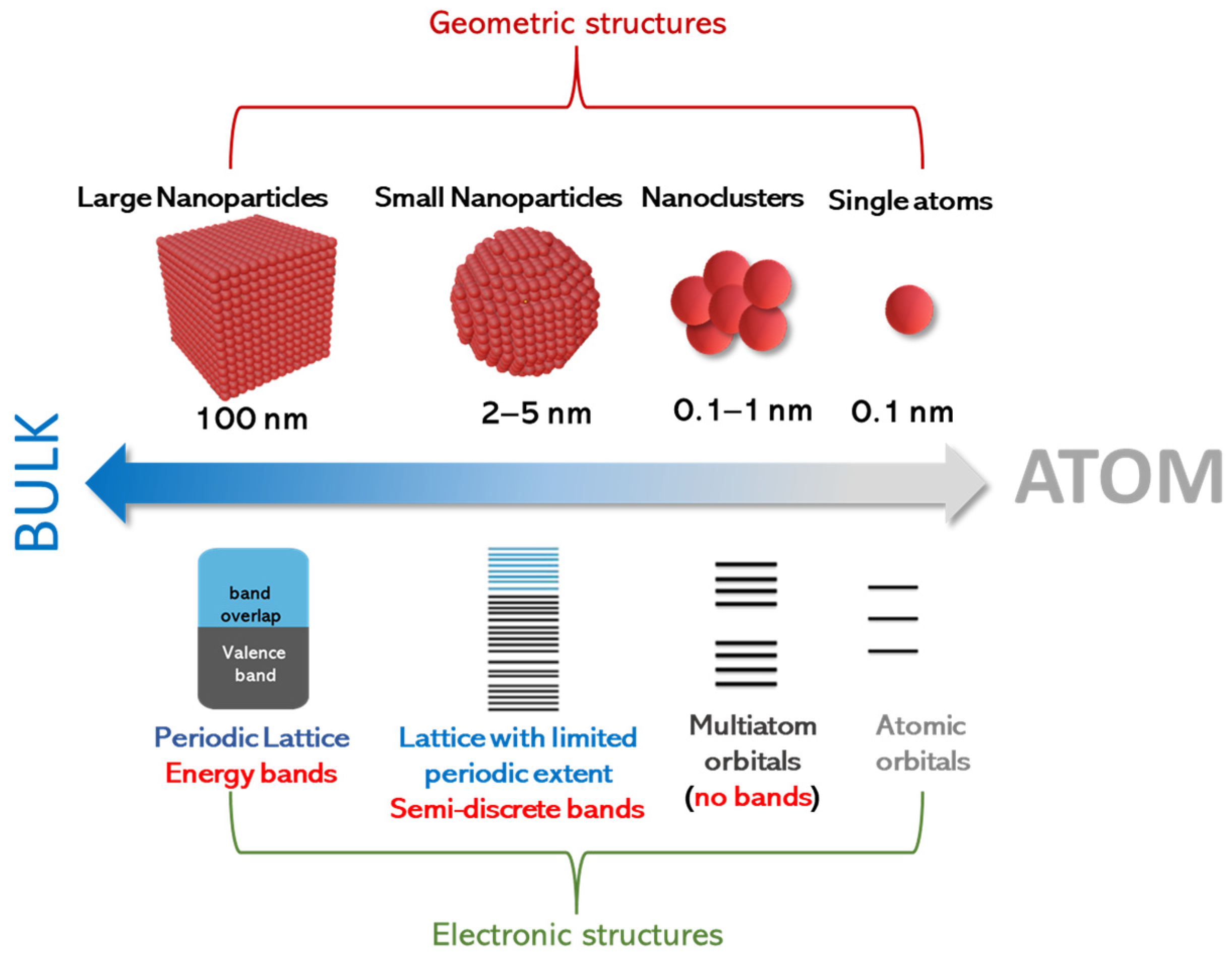
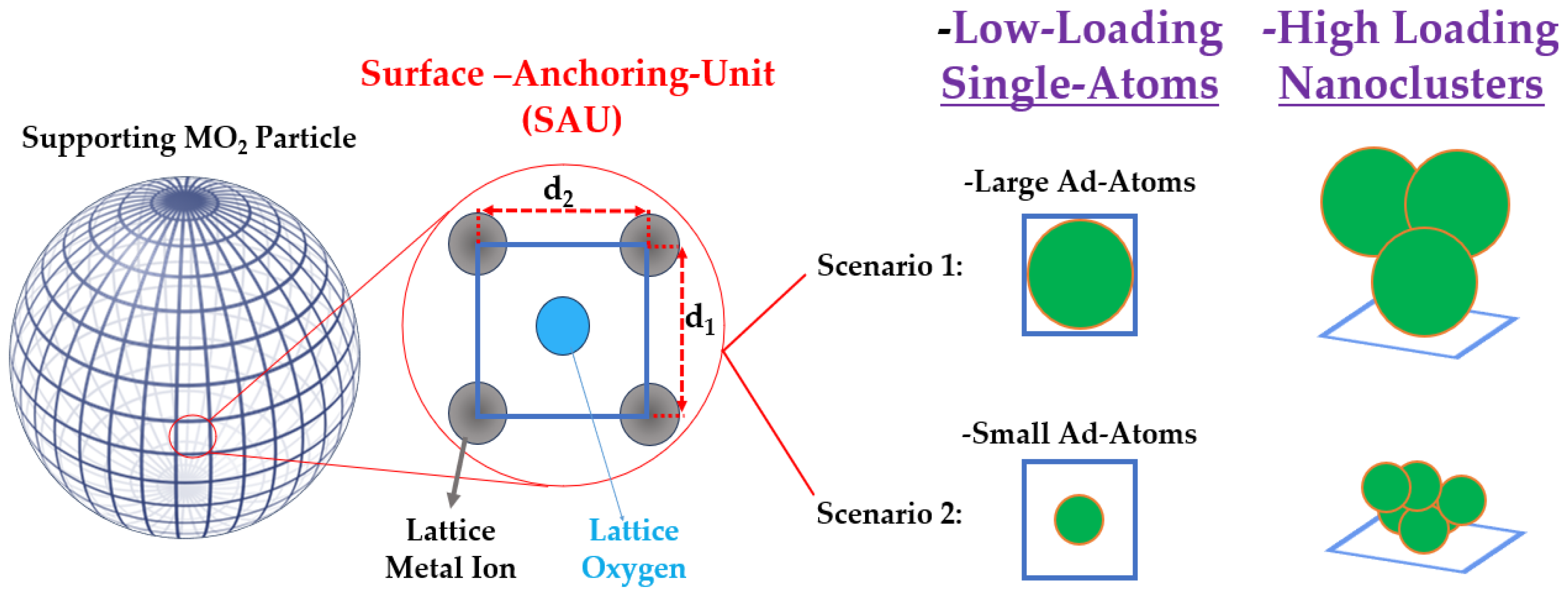
| Characterization Technique | Advantages | Limitations |
|---|---|---|
| AC HAADF-STEM | Visual mapping | Expensive equipment may damage the sample |
| XAS | Local structural and electronic information | Requires synchrotron facilities and advanced modeling software |
| XPS | Surface sensitive | Sample-destructive, unreliable for low-loading |
| EPR | High resolution | Limited to paramagnetic species |
| CO-DRIFT | Can distinguish single atoms from small nanoclusters | Signals often overlap, may react with the sample |
Disclaimer/Publisher’s Note: The statements, opinions and data contained in all publications are solely those of the individual author(s) and contributor(s) and not of MDPI and/or the editor(s). MDPI and/or the editor(s) disclaim responsibility for any injury to people or property resulting from any ideas, methods, instructions or products referred to in the content. |
© 2025 by the authors. Licensee MDPI, Basel, Switzerland. This article is an open access article distributed under the terms and conditions of the Creative Commons Attribution (CC BY) license (https://creativecommons.org/licenses/by/4.0/).
Share and Cite
Spyrou, A.V.; Zodhiates, K.; Deligiannakis, Y. Comparison of Single Atoms vs. Sub-Nanoclusters as Co-Catalysts in Perovskites and Metal Oxides for Photocatalytic Technologies. Nanomaterials 2025, 15, 226. https://doi.org/10.3390/nano15030226
Spyrou AV, Zodhiates K, Deligiannakis Y. Comparison of Single Atoms vs. Sub-Nanoclusters as Co-Catalysts in Perovskites and Metal Oxides for Photocatalytic Technologies. Nanomaterials. 2025; 15(3):226. https://doi.org/10.3390/nano15030226
Chicago/Turabian StyleSpyrou, Anastasia V., Konstantinos Zodhiates, and Yiannis Deligiannakis. 2025. "Comparison of Single Atoms vs. Sub-Nanoclusters as Co-Catalysts in Perovskites and Metal Oxides for Photocatalytic Technologies" Nanomaterials 15, no. 3: 226. https://doi.org/10.3390/nano15030226
APA StyleSpyrou, A. V., Zodhiates, K., & Deligiannakis, Y. (2025). Comparison of Single Atoms vs. Sub-Nanoclusters as Co-Catalysts in Perovskites and Metal Oxides for Photocatalytic Technologies. Nanomaterials, 15(3), 226. https://doi.org/10.3390/nano15030226







